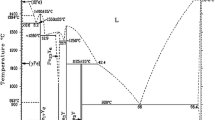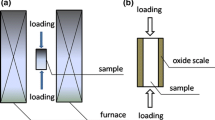Abstract
The oxidation behavior of a commercially available Fe–22Cr alloy coated with a Co3O4 layer by metal organic—chemical vapor deposition was investigated in air with 1% H2O at 1,173 K and compared to the oxidation behavior of the non-coated alloy. The oxide morphology was examined with X-ray diffraction, electron microscopy, and energy dispersive X-ray spectroscopy. Cr2O3 developed in between the Co3O4 coating and the alloy, while alloying elements of the substrate were incorporated into the coating. Particular attention was devoted to possible sources of growth stresses and the effect of the growth stresses on microstructure evolution in the scales that developed on the non-coated and the coated Fe–22Cr alloy. Microstructural features suggested that scale spallation on coated Fe–22Cr occurred as a result of superimposing thermal stresses during cooling onto the growth stresses, that had developed during oxidation.







Similar content being viewed by others
Notes
XRD was performed in transmission geometry with ψ maintained at 90° (sin2(ψ)-method). The strains were measured by the shift of the peaks in the 2θ-range: 10–30°. Calibration was performed before each measurement using a Cr2O3 powder reference
The sin2(ψ)-method was used in the stress measurement. The diffraction of the (166) plane (∼2θ-range: 53–56°) was measured at different tilt-angles. Calibration was performed using a Cr2O3 powder reference
The measurements were performed by XRD using the sin2(ψ)-method. The diffraction of the (226) lattice plane in Cr2O3 (∼2θ-range: 143–156°) was measured at different tilt-angles. The peak overlapped with the diffraction peak from the (311) planes in the Ni–30Cr substrate at temperatures above 873 K
The stress measurements were performed by Raman spectroscopy
It is noted that the present observations are consistent with the hypothesis in ref 21 that whiskers grow under conditions where the supply of oxygen atoms is limited
References
W. J. Quadakkers, J. Piron-Abellan, V. Shemet, and L. Singheiser, Material at High Temperature 20, 115 (2003)
P. Kofstad, High Temperature Corrosion (Elsevier Applied Science, UK, 1988) pp. 361–369
Y. P. Jacob, V. A. C. Haanappel, M. F. Stroosnijder, H. Buscail, P. Fielitz, and G. Borchardt, Corrosion Science 44, 2027 (2002)
S. Chevalier, G. Bonnet, P. Fielitz, G. Strehl, S. Weber, G. Borchardt, J. C. Colson, and J. P. Larpin, Material at High Temperature 17, 247 (2000)
S. Chevalier, G. Strehl, J. Favergeon, F. Desserrey, S. Weber, O. Heintz, G. Borchardt, and J. P. Larpin, Material at High Temperature 20, 253 (2003)
H. E. Evans, International Materials Reviews 40, 1 (1995)
J. G. Goedjen, J. H. Stout, Q. Guo, and D. A. Shores, Materials Science and Engineering A177, 115 (1994)
J. Mougin, N. Rosman, G. Lucazeau, and A. Galerie, Journal of Raman Spectroscopy 32, 739 (2001)
D. Zhu, J. H. Stout, and D. A. Shores, Materials Science Forum 251–254, 333 (1997)
M. Schütze, in Electronic Proc. Intern. Symposium “Corrosion Science in the 21st Century”, 7th–11th of July 2003, Manchester, UK
S. Daghigh, J. L. Lebrun, and A. M. Huntz, Materials Science Forum 251–254, 381 (1997)
A. M. Huntz, S. Daghigh, A. Piant, and J. L. Lebrun (1998) Materials Science and Engineering A248, 44 (1997)
J. Mougin, A. Galerie, G. Lucazeau, and L. Abello, Materials Science Forum 369–372, 841 (2001)
Z. Suo, J. Mech. Phys. Solids, 43, 829 (1995)
Y. Larring and T. Norby, Journal of Electrochemical Society 147, 3251 (2000)
Sandvik AB, Sweden (www.sandvik.com)
M. Burriel, G. Garcia, J. Santiso, A. N. Hansson, S. Linderoth, and A. Figueras, Thin Solid Films 473, 98 (2005)
K. Ledjeff, A. Rahmel, and M. Schorr, Werkstoffe Korrosion 30, 767 (1979)
M. Lenglet, F. Delaunay, and B. Lefez, Materials Science Forum 251–254, 267 (1997)
A. N. Hansson and M. A. J. Somers, Materials at High Temperature 22, 223 (2005)
H. Kurokawa, K. Kawamura, and T. Maruyama, Solid State Ionics 168, 13 (2004)
R. E. Lobnig, H. P. Schmidt, K. Hennesen, and H. J. Grabke, Oxidation Metals 37, 81 (1992)
R. J. Makkonen, Suomen Kemistilehti B35, 230 (1962)
A. N. Hansson, S. Linderoth, M. Mogensen, and M. A. J. Somers, Journal of Alloys and Compounds 402, 194 (2005)
S. C. Tsai, A. M. Huntz, C. Dolin, and C. Monty, Radiation Effects Defect Solids 137, 285 (1995)
S. C. Tsai, A. M. Huntz, and C. Dolin, Materials Science and Engineering A212, 6 (1996)
X. Chen, J. W. Hutchinson, M. Y. He, and A. G. Evans, Acta Materialia 51, 2017 (2003)
D. L. Beke, I. A. Szabó, Z. Erdélyi, and G. Opposits, Materials Science and Engineering A 387–389, 4 (2004)
L. Mikkelsen and S. Linderoth, Materials Science and Engineering A361, 198 (2003)
A. N. Hansson, Ph.D. Thesis, “Oxides in the Co–Cr–Fe–O system and oxidation of coated Fe–22Cr”, 2004
Acknowledgement
Dr. Leona Korcakova, Risø National Laboratory, is acknowledged for assistance with the TEM investigation.
Author information
Authors and Affiliations
Corresponding author
Rights and permissions
About this article
Cite this article
Hansson, A.N., Burriel, M., Garcia, G. et al. Oxidation of Fe–22Cr Coated with Co3O4: Microstructure Evolution and the Effect of Growth Stresses. Oxid Met 68, 23–36 (2007). https://doi.org/10.1007/s11085-007-9060-3
Received:
Revised:
Published:
Issue Date:
DOI: https://doi.org/10.1007/s11085-007-9060-3




